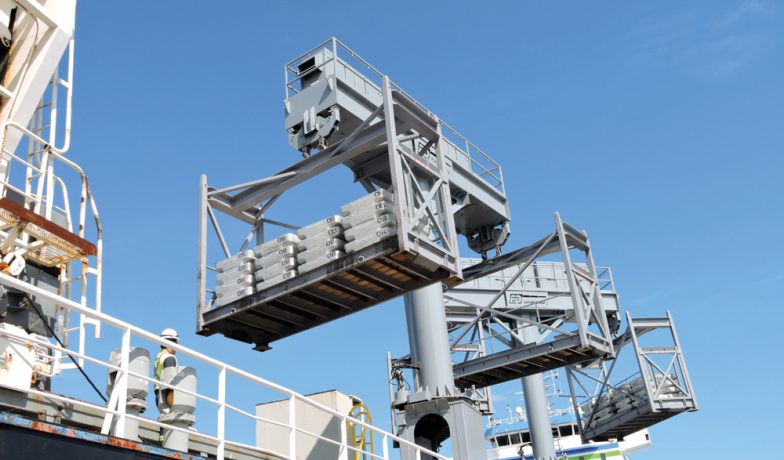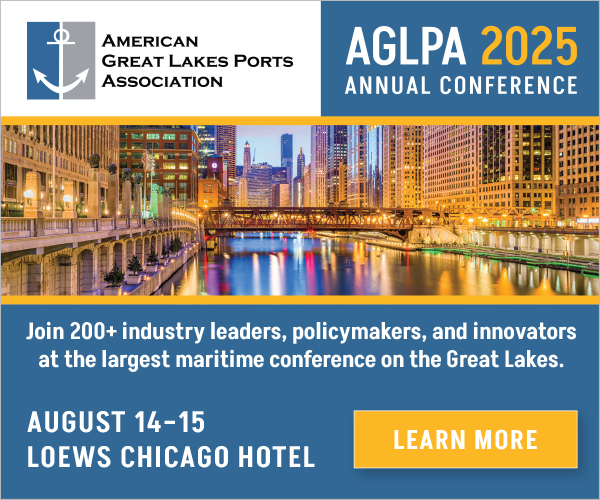Moving Forward: Port of Oswego is making moves to prepare for the future
Scriber has held this position for four years, but he also worked for the POA for several years prior to becoming its director. Over these past four years, Oswego has definitely moved forward. In fact, in three of those four years, including 2022, the Port of Oswego received the Robert J. Lewis Pacesetter Award given by the Great Lakes St. Lawrence Seaway Development Corporation to U.S. Great Lakes ports that have experienced major increases in cargo tonnage.
Oswego celebrated a record year in 2022. Shipping was up 300 percent over 2021, with the port receiving 154,250 metric tons of cargo.
“Our 2022 performance firmly establishes us as a Great Lakes commerce force and a gateway to the world,” Scriber said. In fact, its strategic location puts Oswego fewer than 350 miles from 60 million people. “We’re also the gateway from Lake Ontario to the New York State Canal system, with the entrance through Lock 8 here in Oswego,” he said. Additionally, the Port of Oswego recently received a U.S. Department of Transportation (USDOT) designation as a USDOT Marine Highway, one of only 32 such designations in the United States.
Oswego remains the last stevedoring port on the Great Lakes. “That means we operate as a business,” Scriber said. “We own all our own equipment, from forklifts to cranes. “We support our own infrastructure needs, from roofs to rails to computer software. We hire our own labor and have specific labor agreements.” In effect, the port oversees projects across all aspects of port operations.
“We have been very successful with that,” Scriber said.
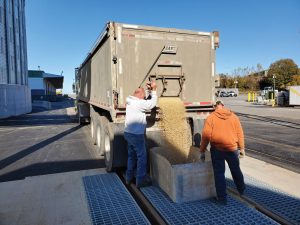 Today’s multimodal operation moves commodities via vessel, truck and rail. Current cargo handled includes grain, aluminum, salt, fertilizer, petroleum products, cement, nuclear power plant components, windmill parts and more.
Today’s multimodal operation moves commodities via vessel, truck and rail. Current cargo handled includes grain, aluminum, salt, fertilizer, petroleum products, cement, nuclear power plant components, windmill parts and more.
More than two centuries ago, in 1799, Oswego was designated by the U.S. Congress as the first port of entry into the young country. Later, in 1828, the Oswego Canal connected to the New York Barge Canal, creating the most direct route from the Atlantic to the Great Lakes. Major commodities handled throughout the early years included furs, salt, lumber, grain, and coal.
Harbor and port operation evolved over the years. The current Port of Oswego Authority (POA) was created in 1960. Between 1960 and 1963, physical changes were made, creating the current port layout on the Oswego River’s east side. Additional major physical improvements over the last 10 years include upgraded rail access and service, heavy equipment acquisition, marine improvements, and expansion of container facilities. In addition to its ideal location in central New York, there are no overhead restrictions, and the location provides access to relatively uncongested over-the-road travel routes. Scriber pointed out that the Port of Oswego is currently operating at 110 percent occupancy.
Foreign Trade Zone
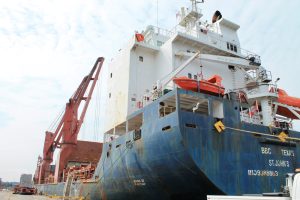 In February 2023, the Port of Oswego obtained Foreign Trade Zone (FTZ) designation for goods arriving by boat, truck, or rail. When goods come into the FTZ, companies will save time and money on duties, tariffs and production costs. FTZs allow for no duties and federal excise taxes to be paid until a finished product is brought from the FTZ to the domestic market or a NAFTA country.
In February 2023, the Port of Oswego obtained Foreign Trade Zone (FTZ) designation for goods arriving by boat, truck, or rail. When goods come into the FTZ, companies will save time and money on duties, tariffs and production costs. FTZs allow for no duties and federal excise taxes to be paid until a finished product is brought from the FTZ to the domestic market or a NAFTA country.
According to Leonard Rauch, senior economic development specialist for the Onondaga County Office of Economic Development, another FTZ advantage is that manufacturing operations can be established within an FTZ, and scrap or byproducts would not be subject to duty fees.
“We just got the [FTZ] okay a month ago,” Scriber said in early March. “This time next year, we’ll have a busy, thriving FTZ. As an FTZ, we can offer additional benefits to businesses working with us at the port. Businesses pay no duty on commodities while in an FTZ until they are released for consumption.” Other user advantages include streamlining logistics and the ability to closely track inventory.
The fact that Oswego is the only FTZ on Lake Ontario is “another arrow in our quiver,” Scriber said. “A number of companies are now interested in locating their goods here.”
There are currently 191 active FTZs in the 50 states and Puerto Rico, with more than 3,200 companies utilizing the program.
Cargo and Cooperation
Oswego also boasts the only grain export facility on Lake Ontario in New York. About 100 local farmers are now sending grain to market via the port facilities. Scriber said that Oswego usually handles one of the first Seaway grain export cargoes of the season, and 2023 should be no different.
The port’s Regional Agricultural Export Center opened a USDA, state-of-the-art grain testing lab in May 2022. Oswego’s two-year-old grain silo holds up to 22,000 metric tons and currently operates at 100 percent capacity. Adding another silo is a real possibility. The current shiploader handles 18,000 bushels per hour. There are plans to add another, operating at 30,000 bushels per hour.
“We are the second largest importer of prime aluminum on the Great Lakes,” Scriber said. Close to 500 aluminum slabs were received in 2022. They supply the Novelis plant in Oswego.
In 2022, the Port of Oswego handled more than 300 wind turbine tower sections, blades, and other large components.
“This is a specialized service that we pride ourselves on and have mastered over the years,” Scriber said.
In fact, Oswego cooperated with the Port of Monroe, Michigan, in handling wind tower sections. Manufactured at Monroe by Ventower Industries, 90 tower sections were loaded onto US-flag barges for shipment to the Port of Oswego, where they were staged with other components for delivery to a project in upstate New York.
“We hope to work again with Monroe,” Scriber said.
Upgrades
Over the past year and a half, the port invested in upgrading and expanding its capabilities, and the process continues this year. Last year, Oswego saw $7 million in east dock upgrades and $4 million in west pier retaining wall and dock reconstruction. $17 million in federal funding was earmarked for critical repairs to the entire harbor breakwater, including the foundation of West Pierhead Lighthouse. A $2.1 million contract was awarded for construction of a new deep-water marina with modern docks and facilities.
Also in 2022, an agreement was signed between the port and the U.S. Army Corps of Engineers to deepen Oswego’s harbor, making it accessible to Seawaymax container ships.
Vision
“We are planning for short sea container shipping,” Scriber said.
Part of Oswego’s Vision 2030 Comprehensive Plan, which was prepared in March 2021, is to create a short sea shipping project on Lake Ontario with direct connection to other major Great Lakes ports. One of the key components identified for this service was a high reach stacker.
In October 2022, the port secured a USDOT Maritime Administration Marine Highways Grant for $754,000 toward a low-emission reach stacker. This will expand Oswego’s ability to load and unload containers, both on cargo ships and rail, ensuring the port’s capability to enter the containerized cargo movement. Total cost is estimated at $900,000.
“Our board is focused on making the port a premier transportation facility,” said Francis Enwright, POA board chair. “Acquisition of this new equipment is vital to our vision and our ability to serve our customers, present and future.”
In 2023, the port continues to seek new customers, particularly for agriculture products and wind turbines, while planning for additional growth.
“We have to think outside the box,” Scriber said. “We can’t rest on how things used to be.”
For instance, a proposed solar-heated warehouse would service Novelis and possible future customer Micron. Both companies require heated space. The environmentally friendly warehouse would use rooftop solar panels to provide radiant floor heat. A Port Infrastructure Development Program (PIDP) grant would provide funding.
Rail
Over the past several years, the port has also increased its rail capacity. In addition to renovation of existing rail, a spur was added for 12-14 rail cars.
Upcoming rail improvements, pending grant approval, include the addition of two tracks into the port (making a total of five), and a totally electric engine able to move 12 cars at a time.
Other Facilities
The Port of Oswego is also home to the H. Lee White Maritime Museum, opened in 1982, which is looking to expand its footprint into a new and larger building.
“We’ve been working with them to find funding for a new museum,” Scriber said.
Construction of a new museum building is part of a bigger plan to attract more port business, including cruise ships. “Lake cruises are in Lake Ontario now. They haven’t been here because we don’t have a dock facility for them. The current museum building would work well.”
Washington Fly-In
During the first week of March, the American Great Lakes Ports Association (AGLPA) held its first Washington, D.C., fly-in since the Covid-19 pandemic. Port executives from around the Lakes – including Scriber – met with U.S.senators and representatives, congressional committee staff and maritime and environmental agency leaders, as well as each other.
“Our view is a commercial view,” Scriber said. “It is important that we have open lines of communication with decision makers.”
In Washington, Scriber met with Secretary of Transportation Pete Buttigieg, as well as Adam Tindall-Schlicht, Great Lakes St. Lawrence Seaway Development Corporation administrator; and Representative Marcy Kaptur (OH), co-chair of the Great Lakes Task Force, working with the newly created Great Lakes Authority, which will be involved with the region’s transportation infrastructure.
Scriber noted that other ports are also making great progress. New ideas are flowing.
“We can work together and speak with one voice to make the entire system more vibrant,” he said.
He added, “Our investments over the past several years at the Port of Oswego are gaining notice, with several new customers looking to come to Oswego. My mission is how to make it bigger, better and more resilient than ever. But none of this happens overnight. We are a great port that is growing. We’re doing what ports and intermodal centers are supposed to do. And we have a great staff to work with. It takes a team.”
Moving forward – indeed.
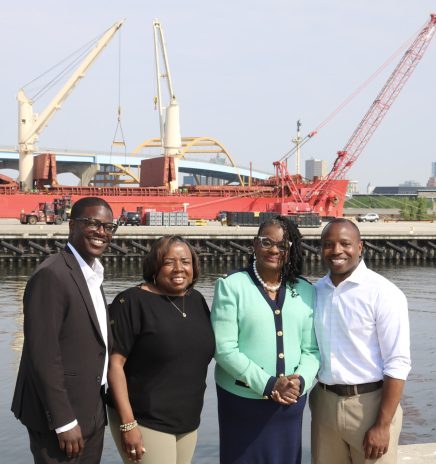
Port Milwaukee Spotlights Significance of Great Lakes Maritime Industry
On June 16, Port Milwaukee hosted an event in recognition of the Great Lakes’ economic value. Congresswoman Gwen Moore, Milwaukee County Executive David Crowley, Milwaukee Mayor Cavalier Johnson and Port... Read More
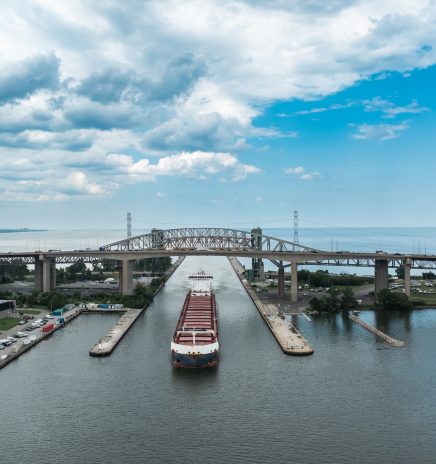
67th Navigation Season Well Underway on the Great Lakes-St. Lawrence Seaway
Despite facing increased economic uncertainty and unpredictability, the 67th navigation season is well underway on the Great Lakes-St. Lawrence Seaway. According to the St. Lawrence Seaway Management Corporation (SLSMC), the... Read More

